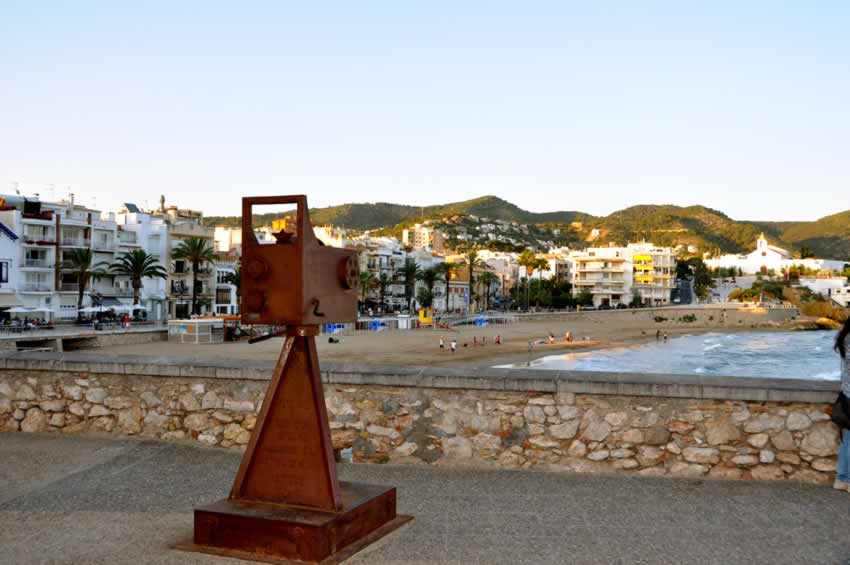
This itinerary starts at the parish church of Sant Bartomeu i Santa Tecla. From the Plaza del Baluard in front of the church there is a great view over the Paseo de la Ribera, la Fragata and the staircase that descends from La Punta to the Plaza de la Fragata. Children like to see the cannon that is set into the Baluard wall aiming out to sea as well as climbing on the adjacent fixed telescopes. From here, the Cau Ferrat and Maricel Museums are practically next-door.
The area in front of the aforementioned museums and at the foot of the Palau Maricel, (Racó de la Calma), is one of Sitges’ most delightful spots and is often enhanced by musicians’ street performances. Look out for the capitals sculpted by artist Pere Jou and the roman sarcophagus found in the 19th century in the vicinity of the
In this area there are some examples of houses built by the Americanos who having made their fortune, returned to Sitges (see map). The itinerary continues down towards the Sant Sebastià beach. On the way a small esplanade opens up facing the sea: the Baluard Vidal i Quadres that hosts a little artisan market in the evenings. The pedestrianized promenade in front of the Sant Sebastià beach has car access limited to neighbours and hotel guests. Children may run around this promenade therefore in relative safety as well as play on the beach and enjoy a swim in good weather. The Sant Sebastià promenade is home to many good restaurants with a wide variety of food styles and prices. Plenty of choice for parents and kids alike.
There are some swings and a slide at the end of the promenade and an open space in front of the Ermita Sant Sebastià. The walk can be continued along the path that borders the Ermita and runs along the top of the cliff in the direction of the Port d’Aiguadolç and ends at the Balmins beach where there are some swings next to the Caleta restaurant.
From there you can access the port from the south (the access for cars is another) using the paved path and stairs that border the cove and run in front of the houses built facing the sea. Aiguadolç has some shops and many restaurants and is lively in the mild and summer months and also at weekends. It is a great place to enjoy a meal or have a drink and enjoy looking at the boats.
Parish Church of Sant Bartomeu & Santa Tecla
The asymmetric parish church of Sant Bartomeu & Santa Tecla (also known as La Punta) is a baroque construction built in the 17th century. Its profile is perhaps the most reproduced image of Sitges.
Built upon the remains of a Romanic and then a gothic church dated 1322, the baroque building has undergone many modifications over the years. Inside are various important altarpieces, the main one is what remains of the centre piece of a 1499 renaissance altarpiece representing Sitges’ patrons Sant Bartomeu & Santa Tecla by Neapolitan artist Nicolás de Credença and is located behind the High Altar. In the side chapels there are baroque altarpieces of the Virgin of Los Remedios, Saint Telmo, Saint Peter, the Immaculate Conception of Mary, Our Lady of the Rosary and Our Lady of Sorrows. Under the choir are the tombs of
Bernat de Fonollar, Galcerán de Ribes and Galcerán de Pacs.
There are various side altars and other features in the church worth noting. On the left hand side (looking towards the High Altar) and starting from the entrance: the altarpiece of the Souls in Purgatory, the Altar of Saint Ramon de Penyafort, Altar of the Virgin of Los Remedios and Saint Joseph (1695), Altar of Saint Telmo, Altar of Saint Peter, Altar of Saint Francisco de Paula and Altar of Piety and the Holy Sepulchre.
On the right hand side (looking towards the High Altar) and starting from the entrance: there is the Baptistery decorated with paintings by Pere Pruna, the sculpture of El Santo Cristo, (Jesus Christ on the cross), the entrance to the Capilla del Santísimo (Chapel of the Most Blessed) built in the 19th century and decorated with paintings by Darius Vilàs, and which gives access to the Chapel of Ecce Homo (also 19th century), the Altar de la Purísima (Altar of the Virgin of the Immaculate Conception), dating from 1694, the Altar of Our Lady of the Rosary, the side chapel of the Virgin of Montserrat with murals by Pere Pruna and finally next to the High Altar is the access to the sacristy.
It is well worth mentioning the baroque organ situated on the right hand side of the church looking towards the Main Altar. It was built in 1690 although it was not completed until 1699. Of this magnificent instrument, the organ case is the only original part to survive to this day, a most excellent reconstruction having been completed in 1985. On the sides of the organ balustrade there are images of the apostles and on the sides of the organ case there are sculptures of four angels depicted as musicians. At the highest point of the decorative casing there is a frieze and cornice with two angels holding a medallion that incorporates the Sitges’ coat of arms and an image of the Immaculate Conception. The Amics de l’Orgue de Sitges (Friends of the Sitges Organ) is an association that promotes and organizes organ concerts, concerts of sacred music and oversees the conservation of this precious instrument.
On the first Wednesday of every month there is a guided tour of the Parish Church. Contact the Sitges Consorci de Patrimoni to make the reservation on Tel. 938940364. The tour will take place provided there is a minimum of 5 people interested. There are sporadic visits to the bell tower carried out on very specific dates. Phone the Consorci de Patrimoni to find out when are the next dates and book ahead as these visits are infrequent and quite popular.

































































